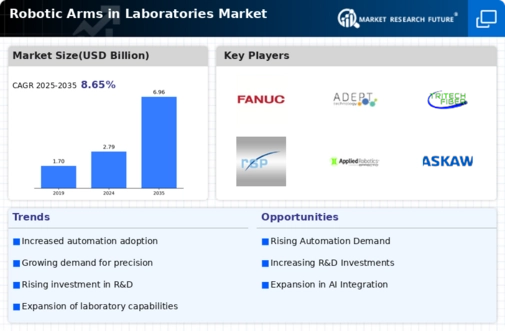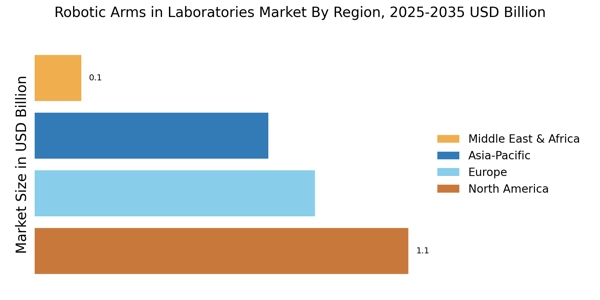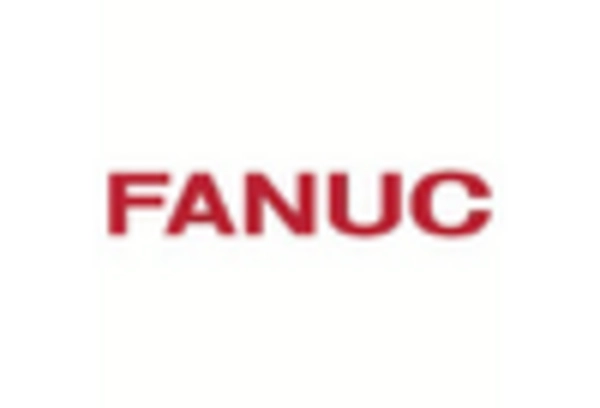Advancements in Robotics Technology
Technological advancements in robotics are significantly influencing the Robotic Arms in Laboratories Market. Innovations such as improved sensors, enhanced mobility, and sophisticated control systems are enabling robotic arms to perform complex tasks with greater precision and reliability. For instance, the introduction of collaborative robots, or cobots, allows for safer interaction between humans and machines, which is particularly beneficial in laboratory settings. Market data indicates that the robotics technology sector is expected to witness a growth rate of around 10% annually, driven by these advancements. As laboratories increasingly adopt these cutting-edge technologies, the demand for robotic arms is likely to rise, facilitating more efficient and streamlined research processes.
Growing Focus on Laboratory Automation
The growing emphasis on laboratory automation is a crucial driver for the Robotic Arms in Laboratories Market. Laboratories are increasingly recognizing the benefits of automating repetitive tasks to enhance efficiency and reduce operational costs. Automation not only minimizes human error but also allows researchers to allocate their time to more complex analytical tasks. Recent statistics suggest that the laboratory automation market is anticipated to expand at a rate of 7% per year, reflecting a broader trend towards mechanization in scientific research. This shift is likely to propel the adoption of robotic arms, as they are integral to automating various laboratory functions, from sample handling to data analysis, thereby revolutionizing traditional laboratory practices.
Regulatory Compliance and Quality Assurance
Regulatory compliance and quality assurance are increasingly becoming critical drivers for the Robotic Arms in Laboratories Market. Laboratories are required to adhere to stringent regulations and standards to ensure the accuracy and reliability of their results. Robotic arms can play a vital role in maintaining compliance by providing consistent and repeatable processes, which are essential for meeting regulatory requirements. The market for laboratory compliance solutions is projected to grow at a rate of 6% per year, indicating a rising awareness of the importance of quality assurance in research. As laboratories strive to enhance their compliance measures, the adoption of robotic arms is likely to increase, as they facilitate standardized procedures and minimize variability in experimental outcomes.
Rising Demand for High Throughput Screening
The increasing need for high throughput screening in laboratories is a pivotal driver for the Robotic Arms in Laboratories Market. As research institutions and pharmaceutical companies strive to accelerate drug discovery and development processes, the demand for robotic arms that can perform multiple tasks simultaneously has surged. According to recent data, the market for high throughput screening is projected to grow at a compound annual growth rate of approximately 8.5% over the next five years. This growth is likely to be fueled by the need for efficiency and accuracy in experimental procedures, which robotic arms can provide. Consequently, the integration of robotic arms into laboratory workflows is becoming more prevalent, as they enhance productivity and reduce human error, thereby transforming the landscape of laboratory operations.
Increased Investment in Research and Development
Increased investment in research and development (R&D) across various sectors is driving the Robotic Arms in Laboratories Market. Governments and private entities are allocating substantial funds to enhance scientific research capabilities, particularly in fields such as biotechnology, pharmaceuticals, and materials science. This influx of capital is fostering innovation and the adoption of advanced technologies, including robotic arms, which are essential for conducting high-quality research. Data indicates that R&D spending is projected to grow by approximately 5% annually, creating a favorable environment for the integration of robotic arms in laboratories. As research institutions seek to improve their operational efficiency and output quality, the demand for robotic arms is expected to rise, further solidifying their role in modern laboratories.


















Leave a Comment